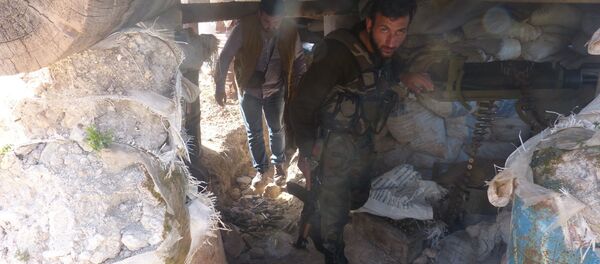The first time that the Syrian army discovered a network of hidden tunnels was back in March 2011, in the area of Deraa. The militants would travel through these tunnels under the al-Omari mosque and from there they could quietly move on to far away regions.
Subsequently, the tunnels appeared in all areas under terrorist control. These tunnels became a powerful weapon in the hands of militants, greatly hampering the liberation efforts of the Syrian army.
City Beneath the City
Recently, however, with the use of modern construction equipment and thousands of captured civilians, the terrorist built real underground cities all over Syria.
The terrorists would hide themselves in the underground shelters, thereby surviving air strikes, whereas peaceful residents would die, as they were not allowed to take cover inside.
All the valuable equipment and warehouses were also inside these underground tunnels. This provided the possibility of covert and quick redeployment, which made an already complicated war in urban conditions extremely complex.
As a result, the Syrian military took years to liberate the cities that were occupied by the militants because the army always prioritized the preservation of civilian lives and was careful in battles near urban infrastructure.
Secret Map of All the Tunnels
A high-ranking source in the Syrian security forces told Sputnik that Russian specialists, who offered militants free corridors upon surrendering, demanded that they give up maps of all the tunnels and provide data on bombs and mines that had been planted.
However, the militants denied the existence of such maps, saying that they remembered all of the passages without putting anything down on paper.
The source went on to say that five years ago, the Syrian government formed a special commission that studies and maps all the discovered tunnels. Currently it is known that 278 underground tunnels were connected from the metropolitan suburbs to Damascus.
Other sources said that commission officers often risked their lives and health when entering these unknown passages. There were cases when terrorists were hiding nearby and would intentionally blow up a tunnel, resulting in commanders and other army personnel being buried alive.
Multi-Purpose Tunnels:
A source who knows the security situation in East Ghouta told Sputnik that the tunnel network is still being studied, because new passes are constantly being discovered.
“Without exaggeration, we can say that they have ransacked the entire territory of the district. They performed a variety of functions. The most popular task of the tunnel was to shelter them from air strikes,” the source said.
Apart from providing shelter and hiding place, these secret passageways also served unusual purposes, such as markets.
"A very large tunnel was recently discovered in Douma, which was used by militants as a huge market. There terrorists and members of their families could buy anything there.”
While at that time the inhabitants living above these tunnels were literally suffering from food shortages.
Cost of the Tunnels
Other materials used in there construction included concrete, iron, cables, cameras and lighting devices. Local residents and engineers noted that these tunnels were made using the best materials.
Who Built the Recent Tunnels?
The sources from the Syrian army told Sputnik that special Western-made equipment was used to drill large tunnels.
Vehicles were delivered to Syria from Turkey and Saudi Arabia through the northern, southern and western borders. All these vehicles were blown up by the militants before they left Ghouta.
Only one surviving drilling machine is now in the possession of the Syrian army.




